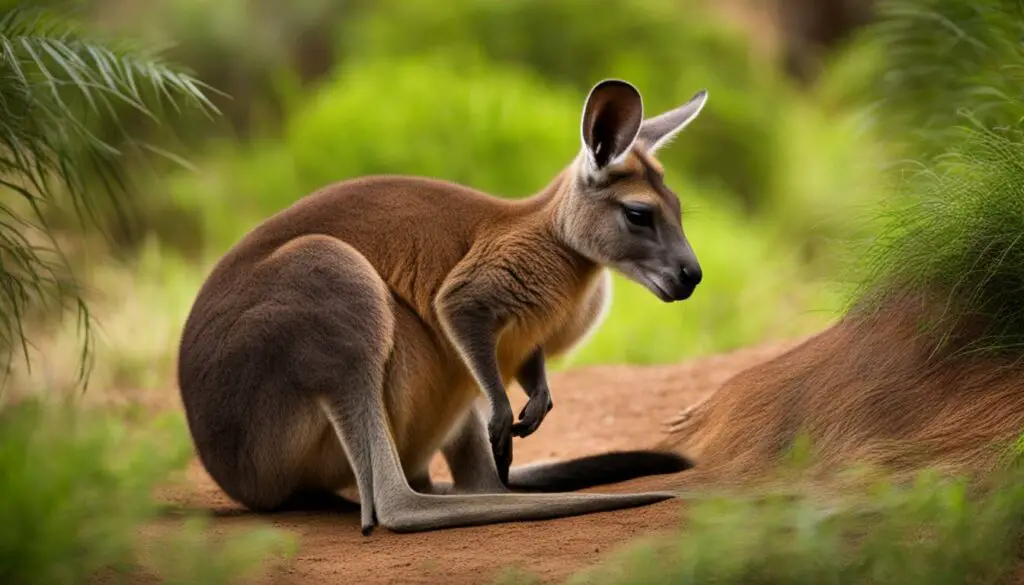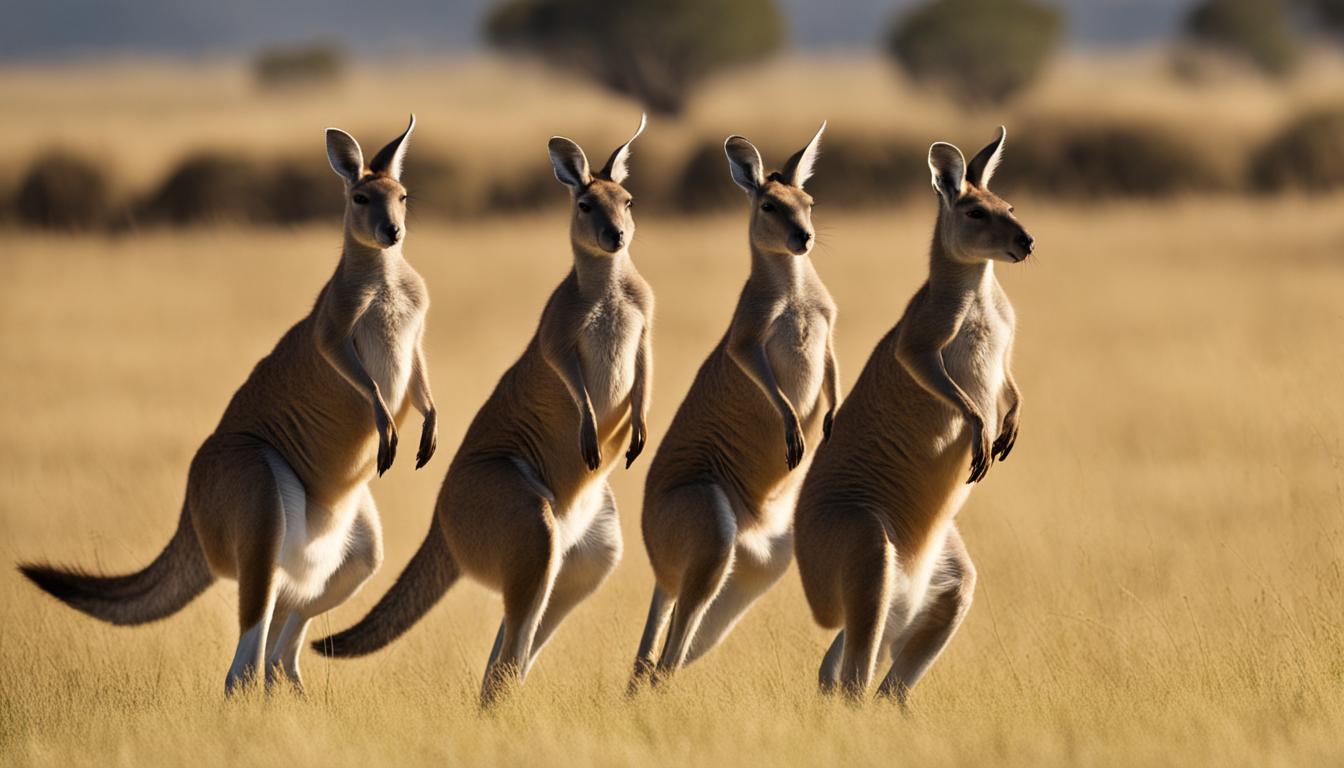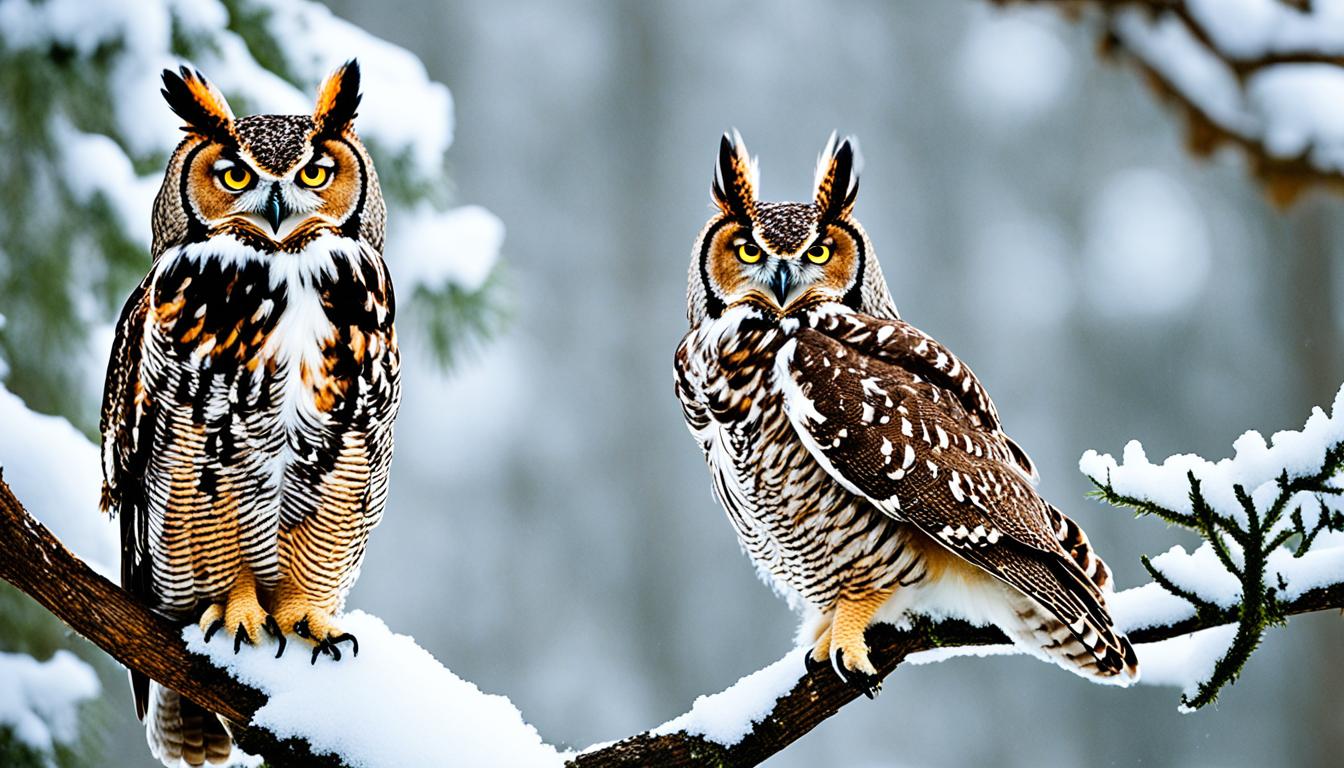Kangaroos, the iconic marsupials of Australia, have evolved a plethora of adaptations that enable them to thrive in their unique environments. These remarkable adaptations encompass physical, behavioral, and structural characteristics, all contributing to their remarkable survival and success in the wild.
When it comes to physical adaptations, kangaroos possess a distinctive appearance that aids in their survival. With their powerful hind legs and large tail, kangaroos are superbly equipped for hopping, providing them with balance and propulsion. Their shortened upper limbs with clawed paws, along with their narrow heads that boast long noses and pointed ears, enable them to navigate their habitats effectively. In terms of coloration, male kangaroos sport red-brown fur, while females showcase a more subdued blue-gray hue.
Another striking adaptation of kangaroos is their marsupial pouch, exclusively found in females. This forward-facing pouch serves as a protective sanctuary where newborn joeys grow and nurse. It not only ensures the survival of their young but also plays a crucial role in nurturing and development.
Behavioral adaptations further contribute to kangaroos’ survival. These nocturnal creatures are active primarily during periods of low light, allowing them to avoid the sweltering heat of the day. Grooming behaviors, such as licking their forearms, aid in heat loss through evaporation, helping them regulate their body temperature. Additionally, kangaroos travel and feed in groups called “mobs,” providing safety in numbers, and exhibit a hierarchical social organization.
Kangaroos have also developed unique locomotion adaptations. These incredible animals rely on hopping, known as saltatory locomotion, as their primary mode of travel. With their powerful hind legs and counterbalancing tail, they can cover impressive distances, capable of leaping up to 30 feet in a single bound.
Surviving in harsh environments necessitates special adaptations, and kangaroos have mastered this art. In the scorching Australian heat, they employ various strategies. Kangaroos sweat while in motion and pant when they stop exercising, effectively regulating their body temperature. Their forearms possess a dense network of blood vessels near the surface of the skin, allowing for efficient heat dissipation through evaporative cooling. To avoid extreme temperatures, kangaroos rest during the hottest parts of the day and graze during the cooler nights or early mornings.
In conclusion, the adaptations exhibited by kangaroos are nothing short of extraordinary. From their physical characteristics to their behavioral and structural intricacies, kangaroos have evolved to be highly specialized and successful in their environments. Exploring these adaptations offers a fascinating glimpse into the marvels of evolution and the remarkable abilities of these unique creatures.
Physical Adaptations of Kangaroos
Kangaroos have evolved a range of physical adaptations that allow them to thrive in their unique environments. These adaptations contribute to their survival, enabling them to excel in various aspects of their lives. Let’s explore some of the key physical adaptations of kangaroos.
One of the most striking physical features of kangaroos is their powerful hind legs. These legs are specifically designed for hopping, their primary mode of transportation. Kangaroos can hop at high speeds up to 35 miles per hour, covering large distances efficiently. Their hind legs also provide them with the ability to leap great heights, enabling them to avoid obstacles and predators.
Another important physical adaptation is their large tail, which serves multiple purposes. The tail acts as a counterbalance, helping kangaroos maintain their balance while hopping. It also acts as a powerful weapon, allowing them to defend themselves against threats by delivering powerful kicks. Additionally, the tail serves as a support when kangaroos are standing still, providing stability.
Physical Adaptations of Kangaroos:
| Adaptation | Description |
|---|---|
| Hind Legs | Powerful legs for hopping and leaping |
| Tail | Acts as a counterbalance, defense mechanism, and support |
| Clawed Paws | Aids in movement and provides grip |
| Narrow Head | Facilitates effective navigation through their environment |
| Long Nose and Pointed Ears | Enhances their senses, helping them detect food and predators |
| Fur Coloration | Males have red-brown fur, while females have a blue-gray coloration |
These physical adaptations, along with their clawed paws, narrow head, long nose, pointed ears, and coloration, collectively contribute to the kangaroo’s ability to thrive in its environment. By understanding and appreciating these adaptations, we gain a deeper understanding of the remarkable nature of kangaroos and their incredible ability to survive and flourish.
How Kangaroos Use Their Marsupial Pouch
Kangaroos, known for their unique adaptations, possess a remarkable characteristic – the marsupial pouch. This forward-facing pouch, exclusive to female kangaroos, serves as a protective haven for the development and nurturing of their offspring, known as joeys. The pouch plays a crucial role in the survival and environmental adaptation of kangaroos.
Within the pouch, the joey attaches itself to the mother’s teat, where it receives nourishment and continues to grow. The pouch provides a safe and secure environment, shielding the joey from potential predators and ensuring its survival in the unpredictable Australian wilderness. As the joey matures, it gradually ventures out of the pouch, slowly adapting to the outside world.
“The marsupial pouch is an incredible adaptation that allows kangaroos to give birth to relatively underdeveloped young while providing them with the necessary protection and care. It showcases the remarkable adaptability of kangaroos in ensuring the successful reproduction and survival of their species,”
The presence of the marsupial pouch is a defining feature of kangaroos and highlights their unique reproductive strategy. It enables kangaroos to navigate their challenging environments successfully, granting them an evolutionary advantage in their quest for survival.

Behavioral Adaptations of Kangaroos
Kangaroos have evolved a range of behavioral adaptations that contribute to their survival in their respective environments. These adaptations enable them to navigate their habitats effectively, avoid predators, and ensure the well-being of their social groups.
One of the key behavioral adaptations of kangaroos is their nocturnal activity. Kangaroos are most active at night and during periods of low light, allowing them to avoid the heat and conserve energy during the day. This behavior helps them stay cool and reduces the risk of dehydration.
Kangaroos also engage in grooming behaviors, such as licking their forearms. This grooming action plays a crucial role in thermoregulation. When the kangaroo licks its forearms, saliva evaporates, cooling the body through evaporative cooling. This behavior helps them regulate their body temperature in the hot Australian climate.
Kangaroos are highly social creatures and usually travel and feed in groups called “mobs.” This behavioral adaptation provides several advantages. Traveling in groups allows them to protect themselves from predators, as there are more individuals to detect and respond to potential threats. Additionally, their hierarchical social organization within the mob helps establish order and reduce conflicts, ensuring cooperation and better chances of survival.
Behavioral Adaptations of Kangaroos
| Behavioral Adaptation | Description |
|---|---|
| Nocturnal Activity | Kangaroos are primarily active at night and during periods of low light to avoid the heat of the day. |
| Grooming | Kangaroos engage in grooming behaviors such as licking their forearms, promoting heat loss through evaporation and aiding in thermoregulation. |
| Social Grouping | Kangaroos travel and feed in groups called “mobs” for protection, with a hierarchical social organization that helps establish order and reduce conflict within the group. |
These behavioral adaptations, combined with their physical and structural adaptations, contribute to the survival and success of kangaroos in their diverse environments. By understanding and studying these adaptations, researchers gain valuable insights into the intricate relationship between organisms and their habitats.
Kangaroo Locomotion Adaptations
Kangaroos have evolved remarkable adaptations for locomotion, allowing them to move efficiently and cover long distances quickly. Their unique form of travel, known as saltatory locomotion, relies on powerful hind legs and a counterbalancing tail.
The hind legs of kangaroos are extremely strong and developed, enabling them to generate powerful thrust for each hop. This allows them to reach speeds of up to 30 miles per hour (48 kilometers per hour) and cover distances of over 25 feet (7.6 meters) in a single leap. The tail serves as a vital component of their locomotion, acting as a counterbalance to maintain stability and balance during hops.
While kangaroos are unable to walk forward or backward like most mammals, their hopping adaptation is highly efficient and energy-saving. Hopping allows them to conserve energy by using less muscle power compared to walking or running. This adaptation is particularly advantageous in their native Australian habitats, where resources can be scarce and long-distance travel is necessary to find food and water.
In summary, kangaroos have developed unique adaptations for locomotion that enable them to move swiftly and efficiently across their environments. The combination of powerful hind legs, a balancing tail, and the ability to hop allows them to cover vast distances in search of resources, making them highly adapted for survival in their native habitats.
Kangaroo Adaptations for Survival in Harsh Environments
Kangaroos have developed remarkable adaptations that enable them to thrive in harsh environments, particularly in the Australian heat. These adaptations help them regulate their body temperature, stay hydrated, and conserve energy, ensuring their survival in challenging conditions.
One of the key adaptations of kangaroos is their ability to sweat while moving and pant when exercising stops. This helps them regulate their body temperature and prevent overheating in hot weather. Additionally, kangaroos have a dense network of blood vessels near the surface of their skin on their forearms. This allows heat to dissipate through evaporative cooling, keeping them cool even in scorching temperatures.
Kangaroos also have behavioral adaptations that contribute to their survival in harsh environments. They rest during the hottest part of the day to conserve energy and avoid the intense sun. Instead, they are more active during the cooler hours of the night or early morning when temperatures are more favorable. This behavior allows them to avoid excessive heat and reduce water loss.
Furthermore, kangaroos have developed specialized methods of obtaining water in arid environments. They extract moisture from their food, which mainly consists of grasses and plants with high water content. Kangaroos also have efficient kidneys that concentrate urine, allowing them to conserve water in their bodies. These physiological adaptations enable them to survive for extended periods without drinking water.
In summary, kangaroos have unique adaptations that help them survive in harsh environments. Their ability to regulate body temperature through sweating, panting, and evaporative cooling, along with their behavioral adaptations for conserving energy and obtaining water, make them resilient and well-suited to their challenging habitats.
Conclusion
Kangaroos exemplify the remarkable power of adaptation, having evolved numerous physical, behavioral, and structural characteristics that contribute to their survival and success in diverse environments. From their powerful hind legs and large tail, which grant them balance and propulsion for hopping, to their unique marsupial pouch that provides a safe haven for their offspring, kangaroos have developed a range of adaptations that ensure their continued existence.
Behaviorally, kangaroos demonstrate their adaptability through their nocturnal activity, allowing them to avoid the scorching heat of the day. Grooming behaviors, such as licking their forearms, facilitate heat loss through evaporation, further aiding their endurance in harsh conditions. In addition, their social organization in groups called “mobs” provides protection and strengthens their chances of survival.
Another distinctive adaptation of kangaroos is their specialized locomotion. Relying solely on hopping, they cover vast distances quickly and efficiently with their powerful hind legs and balancing tail. This unique form of movement, known as saltatory locomotion, serves as a key survival mechanism for kangaroos in their respective habitats.
Overall, kangaroos have proven to be highly specialized and adaptable creatures, with a suite of adaptations that allow them to thrive in their environments. These remarkable features, from physical attributes to behavioral and locomotive adaptations, contribute to the enduring success of kangaroos as a captivating and fascinating species.
What Adaptations Have Kangaroos Developed to Survive Climate Change in Their Habitats?
Kangaroos and climate change have forced kangaroos to adapt to survive. They have evolved to withstand longer droughts and adapt to fluctuating food and water sources. Their strong hind legs also help them travel longer distances to find suitable habitats. These adaptations are crucial for their survival in changing environments.
FAQ
How have kangaroos adapted to their environments?
Kangaroos have evolved numerous adaptations, including physical, behavioral, and structural characteristics, that contribute to their survival and success.
What are the physical adaptations of kangaroos?
Kangaroos have powerful hind legs, a large tail, shortened upper limbs with clawed paws, and narrow heads with long noses and pointed ears, which aid in their balance, propulsion, and effective navigation.
How do kangaroos use their marsupial pouch?
Female kangaroos have a forward-facing pouch where their newborn joey develops and nurses. The pouch provides protection and a safe environment for the joey to grow and develop.
What are the behavioral adaptations of kangaroos?
Kangaroos are active at night and during periods of low light to avoid the heat of the day. They engage in grooming behaviors to promote heat loss through evaporation and travel and feed in groups for protection.
How do kangaroos move around?
Kangaroos rely on hopping, known as saltatory locomotion, to move around. With their powerful hind legs and counterbalancing tail, they can jump up to 30 feet in a single leap.
How do kangaroos adapt to survival in harsh environments?
Kangaroos sweat while moving and pant when exercising stops to regulate their body temperature. They have a dense network of blood vessels near the surface of their skin on their forearms, which allows heat to dissipate through evaporative cooling. They also rest during the hottest part of the day and graze at night or early morning when temperatures are cooler.











